Hejia Zhang
MAGE: A Multi-Agent Engine for Automated RTL Code Generation
Dec 10, 2024



Abstract:The automatic generation of RTL code (e.g., Verilog) through natural language instructions has emerged as a promising direction with the advancement of large language models (LLMs). However, producing RTL code that is both syntactically and functionally correct remains a significant challenge. Existing single-LLM-agent approaches face substantial limitations because they must navigate between various programming languages and handle intricate generation, verification, and modification tasks. To address these challenges, this paper introduces MAGE, the first open-source multi-agent AI system designed for robust and accurate Verilog RTL code generation. We propose a novel high-temperature RTL candidate sampling and debugging system that effectively explores the space of code candidates and significantly improves the quality of the candidates. Furthermore, we design a novel Verilog-state checkpoint checking mechanism that enables early detection of functional errors and delivers precise feedback for targeted fixes, significantly enhancing the functional correctness of the generated RTL code. MAGE achieves a 95.7% rate of syntactic and functional correctness code generation on VerilogEval-Human 2 benchmark, surpassing the state-of-the-art Claude-3.5-sonnet by 23.3 %, demonstrating a robust and reliable approach for AI-driven RTL design workflows.
Improving Model Factuality with Fine-grained Critique-based Evaluator
Oct 24, 2024Abstract:Factuality evaluation aims to detect factual errors produced by language models (LMs) and hence guide the development of more factual models. Towards this goal, we train a factuality evaluator, FenCE, that provides LM generators with claim-level factuality feedback. We conduct data augmentation on a combination of public judgment datasets to train FenCE to (1) generate textual critiques along with scores and (2) make claim-level judgment based on diverse source documents obtained by various tools. We then present a framework that leverages FenCE to improve the factuality of LM generators by constructing training data. Specifically, we generate a set of candidate responses, leverage FenCE to revise and score each response without introducing lesser-known facts, and train the generator by preferring highly scored revised responses. Experiments show that our data augmentation methods improve the evaluator's accuracy by 2.9% on LLM-AggreFact. With FenCE, we improve Llama3-8B-chat's factuality rate by 14.45% on FActScore, outperforming state-of-the-art factuality finetuning methods by 6.96%.
Multi-IF: Benchmarking LLMs on Multi-Turn and Multilingual Instructions Following
Oct 21, 2024Abstract:Large Language Models (LLMs) have demonstrated impressive capabilities in various tasks, including instruction following, which is crucial for aligning model outputs with user expectations. However, evaluating LLMs' ability to follow instructions remains challenging due to the complexity and subjectivity of human language. Current benchmarks primarily focus on single-turn, monolingual instructions, which do not adequately reflect the complexities of real-world applications that require handling multi-turn and multilingual interactions. To address this gap, we introduce Multi-IF, a new benchmark designed to assess LLMs' proficiency in following multi-turn and multilingual instructions. Multi-IF, which utilizes a hybrid framework combining LLM and human annotators, expands upon the IFEval by incorporating multi-turn sequences and translating the English prompts into another 7 languages, resulting in a dataset of 4,501 multilingual conversations, where each has three turns. Our evaluation of 14 state-of-the-art LLMs on Multi-IF reveals that it presents a significantly more challenging task than existing benchmarks. All the models tested showed a higher rate of failure in executing instructions correctly with each additional turn. For example, o1-preview drops from 0.877 at the first turn to 0.707 at the third turn in terms of average accuracy over all languages. Moreover, languages with non-Latin scripts (Hindi, Russian, and Chinese) generally exhibit higher error rates, suggesting potential limitations in the models' multilingual capabilities. We release Multi-IF prompts and the evaluation code base to encourage further research in this critical area.
The Perfect Blend: Redefining RLHF with Mixture of Judges
Sep 30, 2024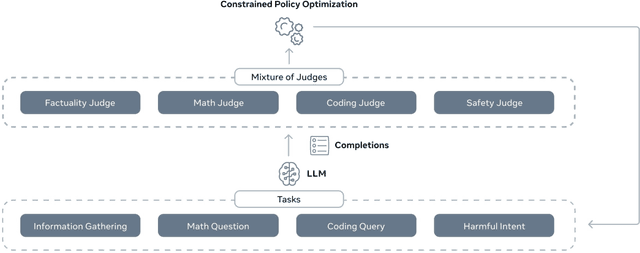
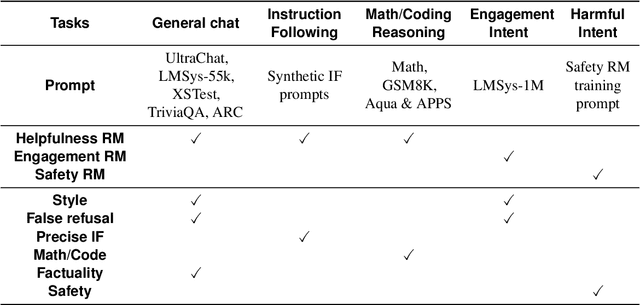
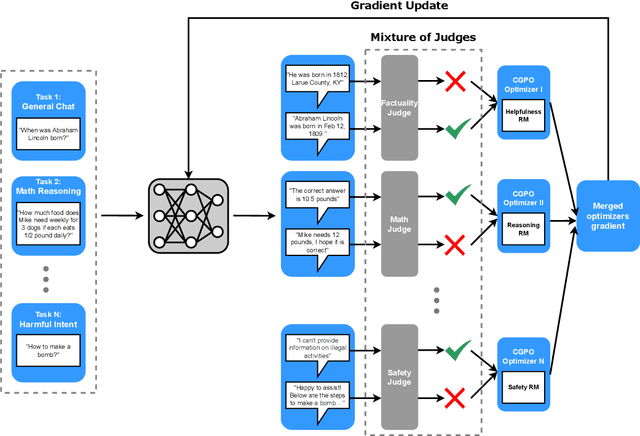
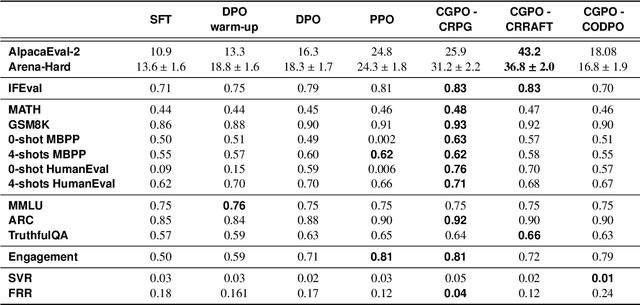
Abstract:Reinforcement learning from human feedback (RLHF) has become the leading approach for fine-tuning large language models (LLM). However, RLHF has limitations in multi-task learning (MTL) due to challenges of reward hacking and extreme multi-objective optimization (i.e., trade-off of multiple and/or sometimes conflicting objectives). Applying RLHF for MTL currently requires careful tuning of the weights for reward model and data combinations. This is often done via human intuition and does not generalize. In this work, we introduce a novel post-training paradigm which we called Constrained Generative Policy Optimization (CGPO). The core of CGPO is Mixture of Judges (MoJ) with cost-efficient constrained policy optimization with stratification, which can identify the perfect blend in RLHF in a principled manner. It shows strong empirical results with theoretical guarantees, does not require extensive hyper-parameter tuning, and is plug-and-play in common post-training pipelines. Together, this can detect and mitigate reward hacking behaviors while reaching a pareto-optimal point across an extremely large number of objectives. Our empirical evaluations demonstrate that CGPO significantly outperforms standard RLHF algorithms like PPO and DPO across various tasks including general chat, STEM questions, instruction following, and coding. Specifically, CGPO shows improvements of 7.4% in AlpacaEval-2 (general chat), 12.5% in Arena-Hard (STEM & reasoning), and consistent gains in other domains like math and coding. Notably, PPO, while commonly used, is prone to severe reward hacking in popular coding benchmarks, which CGPO successfully addresses. This breakthrough in RLHF not only tackles reward hacking and extreme multi-objective optimization challenges but also advances the state-of-the-art in aligning general-purpose LLMs for diverse applications.
GPT-Fabric: Folding and Smoothing Fabric by Leveraging Pre-Trained Foundation Models
Jun 14, 2024Abstract:Fabric manipulation has applications in folding blankets, handling patient clothing, and protecting items with covers. It is challenging for robots to perform fabric manipulation since fabrics have infinite-dimensional configuration spaces, complex dynamics, and may be in folded or crumpled configurations with severe self-occlusions. Prior work on robotic fabric manipulation relies either on heavily engineered setups or learning-based approaches that create and train on robot-fabric interaction data. In this paper, we propose GPT-Fabric for the canonical tasks of fabric folding and smoothing, where GPT directly outputs an action informing a robot where to grasp and pull a fabric. We perform extensive experiments in simulation to test GPT-Fabric against prior state of the art methods for folding and smoothing. We obtain comparable or better performance to most methods even without explicitly training on a fabric-specific dataset (i.e., zero-shot manipulation). Furthermore, we apply GPT-Fabric in physical experiments over 12 folding and 10 smoothing rollouts. Our results suggest that GPT-Fabric is a promising approach for high-precision fabric manipulation tasks.
Multi-Robot Geometric Task-and-Motion Planning for Collaborative Manipulation Tasks
Oct 13, 2023Abstract:We address multi-robot geometric task-and-motion planning (MR-GTAMP) problems in synchronous, monotone setups. The goal of the MR-GTAMP problem is to move objects with multiple robots to goal regions in the presence of other movable objects. We focus on collaborative manipulation tasks where the robots have to adopt intelligent collaboration strategies to be successful and effective, i.e., decide which robot should move which objects to which positions, and perform collaborative actions, such as handovers. To endow robots with these collaboration capabilities, we propose to first collect occlusion and reachability information for each robot by calling motion-planning algorithms. We then propose a method that uses the collected information to build a graph structure which captures the precedence of the manipulations of different objects and supports the implementation of a mixed-integer program to guide the search for highly effective collaborative task-and-motion plans. The search process for collaborative task-and-motion plans is based on a Monte-Carlo Tree Search (MCTS) exploration strategy to achieve exploration-exploitation balance. We evaluate our framework in two challenging MR-GTAMP domains and show that it outperforms two state-of-the-art baselines with respect to the planning time, the resulting plan length and the number of objects moved. We also show that our framework can be applied to underground mining operations where a robotic arm needs to coordinate with an autonomous roof bolter. We demonstrate plan execution in two roof-bolting scenarios both in simulation and on robots.
Effective Long-Context Scaling of Foundation Models
Sep 27, 2023



Abstract:We present a series of long-context LLMs that support effective context windows of up to 32,768 tokens. Our model series are built through continual pretraining from Llama 2 with longer training sequences and on a dataset where long texts are upsampled. We perform extensive evaluation on language modeling, synthetic context probing tasks, and a wide range of research benchmarks. On research benchmarks, our models achieve consistent improvements on most regular tasks and significant improvements on long-context tasks over Llama 2. Notably, with a cost-effective instruction tuning procedure that does not require human-annotated long instruction data, the 70B variant can already surpass gpt-3.5-turbo-16k's overall performance on a suite of long-context tasks. Alongside these results, we provide an in-depth analysis on the individual components of our method. We delve into Llama's position encodings and discuss its limitation in modeling long dependencies. We also examine the impact of various design choices in the pretraining process, including the data mix and the training curriculum of sequence lengths -- our ablation experiments suggest that having abundant long texts in the pretrain dataset is not the key to achieving strong performance, and we empirically verify that long context continual pretraining is more efficient and similarly effective compared to pretraining from scratch with long sequences.
Surrogate Assisted Generation of Human-Robot Interaction Scenarios
May 11, 2023



Abstract:As human-robot interaction (HRI) systems advance, so does the difficulty of evaluating and understanding the strengths and limitations of these systems in different environments and with different users. To this end, previous methods have algorithmically generated diverse scenarios that reveal system failures in a shared control teleoperation task. However, these methods require directly evaluating generated scenarios by simulating robot policies and human actions. The computational cost of these evaluations limits their applicability in more complex domains. Thus, we propose augmenting scenario generation systems with surrogate models that predict both human and robot behaviors. In the shared control teleoperation domain and a more complex shared workspace collaboration task, we show that surrogate assisted scenario generation efficiently synthesizes diverse datasets of challenging scenarios. We demonstrate that these failures are reproducible in real-world interactions.
PATO: Policy Assisted TeleOperation for Scalable Robot Data Collection
Dec 09, 2022Abstract:Large-scale data is an essential component of machine learning as demonstrated in recent advances in natural language processing and computer vision research. However, collecting large-scale robotic data is much more expensive and slower as each operator can control only a single robot at a time. To make this costly data collection process efficient and scalable, we propose Policy Assisted TeleOperation (PATO), a system which automates part of the demonstration collection process using a learned assistive policy. PATO autonomously executes repetitive behaviors in data collection and asks for human input only when it is uncertain about which subtask or behavior to execute. We conduct teleoperation user studies both with a real robot and a simulated robot fleet and demonstrate that our assisted teleoperation system reduces human operators' mental load while improving data collection efficiency. Further, it enables a single operator to control multiple robots in parallel, which is a first step towards scalable robotic data collection. For code and video results, see https://clvrai.com/pato
Video Game Level Repair via Mixed Integer Linear Programming
Oct 13, 2020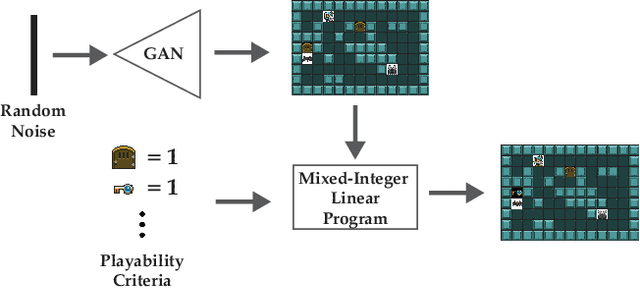

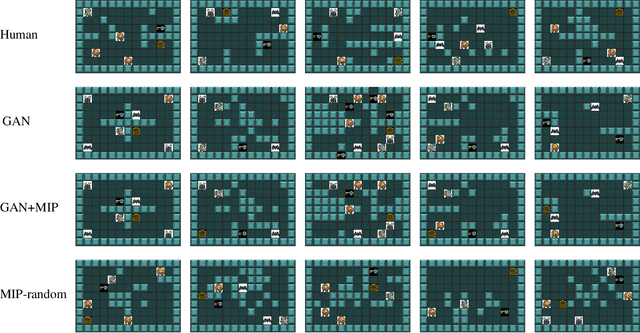

Abstract:Recent advancements in procedural content generation via machine learning enable the generation of video-game levels that are aesthetically similar to human-authored examples. However, the generated levels are often unplayable without additional editing. We propose a generate-then-repair framework for automatic generation of playable levels adhering to specific styles. The framework constructs levels using a generative adversarial network (GAN) trained with human-authored examples and repairs them using a mixed-integer linear program (MIP) with playability constraints. A key component of the framework is computing minimum cost edits between the GAN generated level and the solution of the MIP solver, which we cast as a minimum cost network flow problem. Results show that the proposed framework generates a diverse range of playable levels, that capture the spatial relationships between objects exhibited in the human-authored levels.
 Add to Chrome
Add to Chrome Add to Firefox
Add to Firefox Add to Edge
Add to Edge